UNIVERSITY OF GLASGOW LIBRARY
SPECIAL COLLECTIONS DEPARTMENT
Book of the Month
May
2009
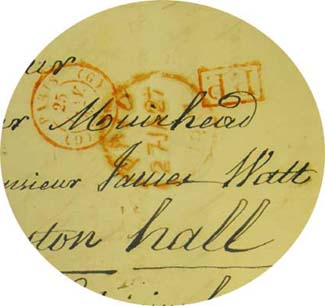
Papers relating to the families of
Muirhead and Watt
Various locations: 16th to
19th centuries
MS Gen 1354
|
This month we feature a collection of papers connected with the life of
the Scottish scientist and engineer James Watt
(1736-1819). His development of steam engines had a profound
effect on methods of manufacturing and transport in the late 18th
and early 19th centuries and after his death his son
James Watt jnr (1769-1848) was concerned to
record his father's achievements. To this end, he enlisted the help of
James Patrick Muirhead (1813-1898) who
published a number of works, culminating in the
Life of James Watt
with Selections from his Correspondence (1858). |
|
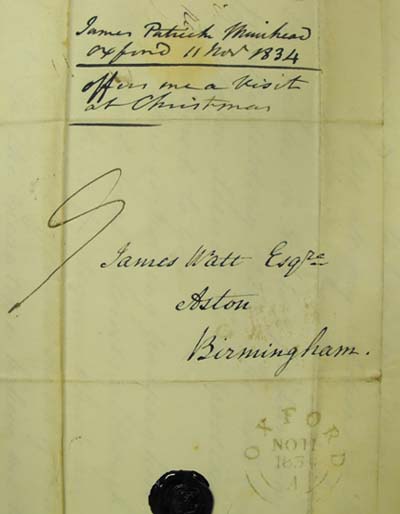
Letter addressed to James Watt jnr by J P Muirhead, 11 November 1834.
The note at the top, in Watt's handwriting, demonstrates his usual practice
of noting the sender's name, date of letter and brief summary of the
contents, in this case "Offers me a visit at Christmas"
MS Gen 1354/265
|
MS Gen 1354 includes over 900 letters exchanged between Watt jnr and Muirhead,
written in the period 1834-1847. They first met while Muirhead was
studying in Oxford; their families were related through
Watt's grandmother, Agnes Muirhead (1703-1755). In a letter to Charles Hampden Turner,
Watt wrote "This will introduce you to my friend and cousin Jas Patrick Muirhead,
a Scotch Barrister..."1
|
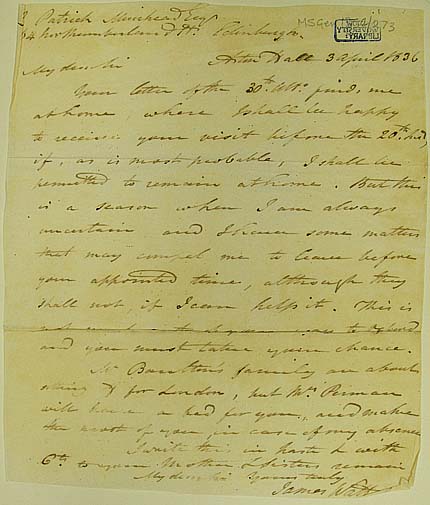
An example of the copies kept by James Watt jnr of
his outgoing letters.
This is addressed to Muirhead and dated 3 April
1836. MS Gen 1354/273
|
|
The Life was a revised and abbreviated version of Muirhead's
three-volume work, The Origin and
Progress of The Mechanical Inventions of James Watt... (1854). A late
20th
century assessment of the biography suggests that, not withstanding
Watt's engineering genius, Muirhead's work was
not wholly accurate or objective. Nevertheless, it remains a valuable
resource and subsequent
scholars "...have not matched his research nor attained the quality of
his style."2 |
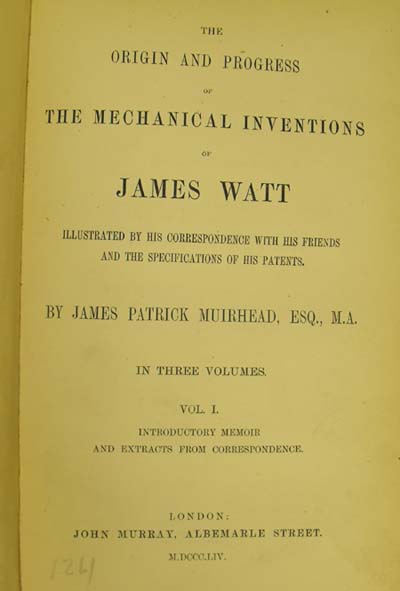
Title page of Muirhead's 1854 publication which
included
an extensive biography of Watt
Sp Coll q536
|
Muirhead's research was wide-ranging; he had access to Watt's papers,
was in regular contact with his son and made enquiries, by letter and in
person, to those who had known him or could speak authoritatively about
his achievements. They included the French physicist,
François Arago
(1786-1853) who, as secretary of the Acad émie
Royale des Sciences, had produced a complimentary Historical Eloge of
James Watt in 1834. Muirhead published a translated version in 1839
and many of his letters to Watt jnr around this date refer to the
preparation of it. The collection also includes a few letters from Arago
in 1847, following Muirhead's publication of Correspondence on the Discovery of
Water (1846) regarding the rival claims of Watt and Henry
Cavendish over the discovery of the composition of water. 3
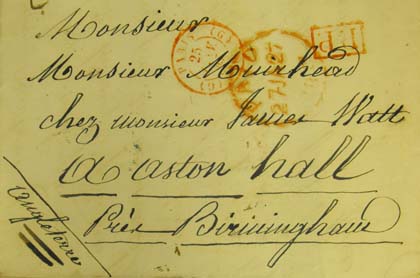
Letter from François
Arago addressed to Muirhead, at the house of
James Watt [Jnr],
Aston Hall, near Birmingham, January 1847
(MS Gen 1354/139)
|
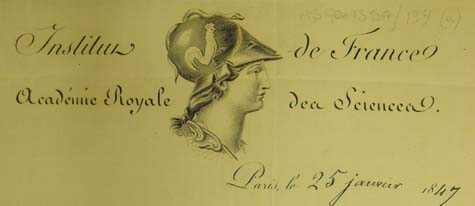
Letterhead: letter from François
Arago to J P Muirhead, 25 January 1847
(MS Gen 1354/139) |
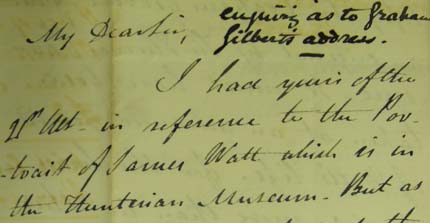
Letter from William Fleming
to J P Muirhead, 9 November 1853
MS Gen 1354/85
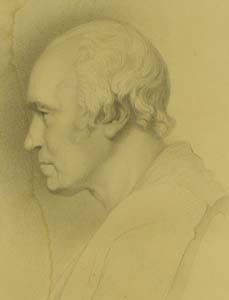
Portrait of
James Watt,
drawn and
engraved by Edward Finden (1791-1857)
from the bust by Sir Francis Chantrey
(Sp Coll q536)
|
Muirhead's other sources included the
University of Glasgow, who had employed James Watt at the start of his
career, as a mathematical instrument maker from 1756 to 1764. In 1848,
William Fleming, Professor of Oriental Languages, sent on a letter
he had received from the Registrar of Births, regarding the Watt family history. A few
years later he also made enquiries "...in reference to the Portrait of
James Watt which is in the Hunterian Museum [at the University of
Glasgow]."4
Watt was the subject of many portraits, statues and busts. Muirhead listed the principal ones
at the end of the
introductory memoir to The Origin and Progress (1854). They
included five full-length statues by Sir
Francis Leggatt Chantrey (1781-1841), one of which was
placed in Glasgow College (also referred to by Fleming in his letter to
Muirhead). Both the statue and portrait remain in the Hunterian collections today.
Chantrey also executed a bust of Watt which "...exemplified for
contemporaries his ability to capture the mind of the sitter."5 This was the source for "The most pleasing pencil
drawing of Mr Watt ... one that was made not from the life, but
from Chantrey's bust, by an artist, Mr. Edward Finden" and was
"...of all the engravings of his father, that by which the late Mr Watt
wished that his image should be conveyed to posterity."6
Consequently, it was used in Muirhead's successive publications about
Watt, beginning with the Eloge.
A letter
from Muirhead to Watt of 27 August 1839 refers to the difficulty
of acquiring it in time for publication.7
|
|
Obtaining an engraving was just one of the difficulties and delays
encountered during the publishing process. There are numerous
references to the publisher John Murray
(1808-1892) in Muirhead's letters to Watt and there is also a sequence of papers relating to
the printing and sales of Muirhead's publications.8 However, despite the preoccupations of researching, writing and
publishing, the letters between Muirhead and Watt are also concerned
with contemporary events, family relations and domestic matters. These
include Muirhead's dispatch of various samples of oatmeal from
Scotland, apparently at the request of Watt's cook. They must have
been favourably received as he wrote a short time later to say
that he was sending larger quantities of all three kinds by
steamer.9
A letter of 13 July 1837 is of particular interest as it describes
Muirhead's train journey from Birmingham to Liverpool, only a week
after the opening of the Grand Junction Railway which made the
journey possible for the first time:
"...notwithstanding your expressed fears, we have reached Liverpool
alive... The stoppages for water ... amounted to 27 minutes. My
sisters, after the first mile, enjoyed it much: and greatly marvelled
to see 'How towns, heaths, acres took to flight, How bridges thundered
as we pass'd!"10
|
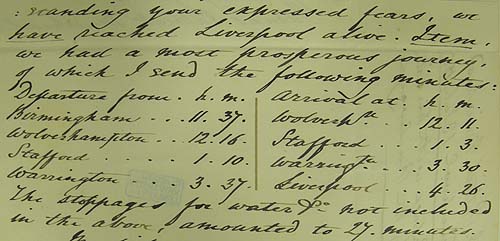
Details of the
journey time between Birmingham and Liverpool by train, July 1837
MS Gen 1354/278
|
It is not clear if Watt's reservations about the train journey
to Liverpool were based on the operation of the (steam) train
itself, the railway track or some other matter. Arguably, he had
made more adventurous journeys himself, albeit forty years
before. Within the collection is a journal titled 'Voyage in
Sicily 1793'. A note on the cover by Muirhead states that he found
it among the papers of Miss E S Wilkinson (a relative
of James Watt jnr) after her death.
It begins with some notes on Sicilian coins, weights and measures.
The entries are concerned with his impressions of places visited,
including historical details, buildings, flora and fauna and
agriculture. There are one or two sketches, including a diagram of
a 'machine for beating the cotton'. |
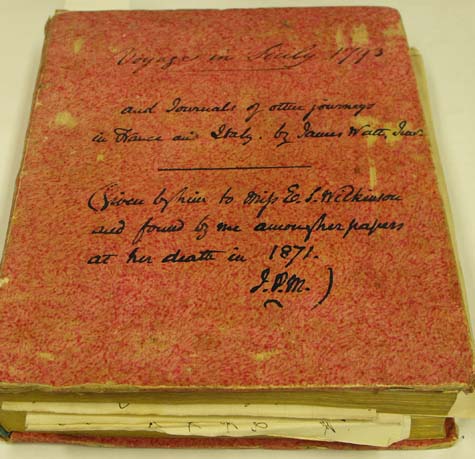
MS Gen 1354/22 |
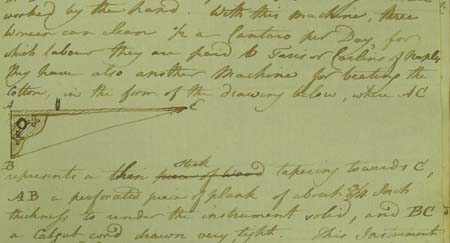
Extract from MS Gen 1354/22. A 'machine for beating the cotton'. |
Another part of the journal records his 'Journey to Paris' beginning on
3 March 1792. Although this was a particularly volatile year in French history, most of the entries are concerned with where he lodged and ate, along
with detailed notes on sightseeing and observations on local industry.
However, on 15 March he "Went to the Chapel Royal at the Tuileries to
see the King and Queen [Louis XVI and Marie Antoinette] & afterwards
went into the drawing room to see them pass. This was the day after
the news of the death of Leopold [Leopold II, Holy Roman Emperor and
Archduke of Austria] arrived & all the Court was in mourning." According to other sources, Watt jnr
witnessed the massacres of 10 August 1792 and was denounced in the
Commons as a traitor because of his activities in Paris, including
addressing the Club des Jacobins.11 Muirhead even quotes a claim that he prevented a duel between
Danton
and Robespierre, two major figures in
the revolution.12 Curiously, the journal records this period as rather uneventful,
dismissing most of the summer in a few lines: "I remained at Paris
during the months of July, August and Sept being confined to my room
with a scarlet fever during the greatest part of the time."
|
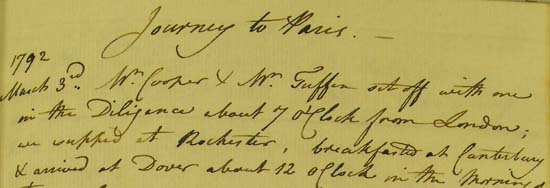
Extracts from MS Gen 1354/22

|
This collection was originally described as 'Papers
pertaining to the family of Muirhead, originally of Lauchop'. Evidently,
J P Muirhead's papers relating to Watt were collected together with
other family papers (the earliest described as a marriage contract from
1579) before being presented to the University of Glasgow by his
great-grandson. They include an interesting sequence of letters from J
P Muirhead's father to his wife.
Lockhart Muirhead
(d 1824) was the
University's librarian from 1795
and also regius professor of natural history from 1807. Two years
earlier he had been entrusted with the transfer of anatomical and
pathological preparations, coins, books and manuscripts and botanical,
geological and other materials from London to Glasgow. These collections
had been bequeathed by William Hunter (1718-1783) to the
university, along with money towards building a museum to house them.
|

Extracts from the minutes of Faculty of
Glasgow College in the University of Glasgow,
3 November 1795. Appointment of Lockhart Muirhead as Librarian
MS Gen 1354/16 |
Muirhead took his task seriously, although the scale of it and the long
hours seemed to take their toll:
"...my days have been devoted to inventories & catalogues..."
"I am now at p.111 of the lists of books, at Lord knows where among the
monkeys & bats..."13
Eventually, the collections arrived safely in Glasgow and the
university's Hunterian museum opened in 1807. There were problems with
the heating system, however, and the University turned to its former
employee; in the museum records there is a letter from James Watt,
by then a famous and respected engineer, concerning the operation of the stove.14
Watt died a few years later but the University received a
permanent reminder of him in the shape of Chantrey's statue, itself the
subject of a painting, later in the 19th century. The statue's
inscription reads "This statue of James Watt ... is presented by his son
to the University of Glasgow in gratitude for the encouragement afforded
by its professors to the scientific pursuits of his father's early
life."15
|
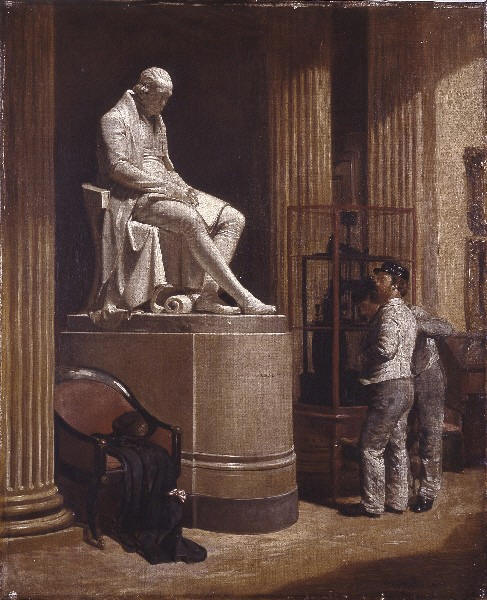
The interior of the First Hunterian Museum with the
Statue of James Watt,
painted by William Stewart (1823-1906)
(Hunterian Museum & Art Gallery, University of Glasgow. Museum No:
44095)
Other items of interest:
See the manuscripts catalogue for an
overview of the contents of
MS Gen 1354
Muirhead, James Patrick, Historical eloge of James Watt by M.
Arago ; translated from the French with additional notes and an appendix
(London:1839)
Library Research
Annexe U12-f.14
Muirhead, James Patrick, The origin and progress of the
mechanical inventions of James Watt illustrated by his correspondence
with his friends and the specification of his patents (London:
1854) Sp Coll
q536-538
Muirhead, James Patrick, The life of James Watt : with
selections from his correspondence (London: 1858)
Library Research
Annexe U12-a.4
The following have
been useful in creating this article:
Arago, François."
Encyclopædia Britannica Online.
Keppie, L J F, William Hunter and the Hunterian
Museum in Glasgow 1807-2007 (Edinburgh: 2007)
Sp Coll Hunterian
Add. q109
Eric H. Robinson, 'Watt,
James (1769-1848)', Oxford Dictionary of National
Biography, Oxford University Press, 2004
[http://www.oxforddnb.com/view/article/28881, accessed
1 May 2009]
Timothy Stevens, 'Chantrey,
Sir Francis Leggatt (1781-1841)', Oxford Dictionary of
National Biography, Oxford University Press, Sept 2004; online
edn, Jan 2008 [http://www.oxforddnb.com/view/article/5113,
accessed
1 May 2009]
B. M. Sturt, 'Muirhead, James
Patrick (1813-1898)', rev. Richard L. Hills, Oxford
Dictionary of National Biography, Oxford University Press, 2004
[http://www.oxforddnb.com/view/article/19507, accessed
1 May 2009]
Biography of James Watt from
The
University of Glasgow Story
References cited in text
1. MS Gen 1354/288
2. B. M. Sturt, 'Muirhead,
James Patrick (1813-1898)', rev. Richard L. Hills,
Oxford Dictionary of National Biography, Oxford University Press,
2004
[http://www.oxforddnb.com/view/article/19507, accessed
1 May 2009]
3. Ibid
4. MS Gen 1354/85
5. Timothy Stevens, 'Chantrey,
Sir Francis Leggatt (1781-1841)', Oxford Dictionary of
National Biography, Oxford University Press, Sept 2004; online
edn, Jan 2008 [http://www.oxforddnb.com/view/article/5113,
accessed
1 May 2009]
6.
Muirhead, James Patrick, The origin and progress of the
mechanical inventions of James Watt illustrated by his correspondence
with
his friends and the specification of his patents (London:
1854) p. cclxxix-cclxxx
7. MS Gen 1354/298]
8. MS Gen 1354/1199-1268
9. MS Gen 1354/555 and /558
10. MS Gen 1354/278
11. Eric H. Robinson, 'Watt,
James (1769-1848)', Oxford Dictionary of National
Biography, Oxford University Press, 2004
[http://www.oxforddnb.com/view/article/28881, accessed
1 May 2009]
12. Muirhead, Op Cit p. cclxi
13. MS Gen 1354/46 and /47
14. MR 47/6
15. Online catalogue entry for GLAHA 44337. Accessed
via Search the Hunterian
Collections
Return to main Special Collections
Exhibition Page
Go to previous
Books of the Month
Sarah Hepworth May 2009 |
|



